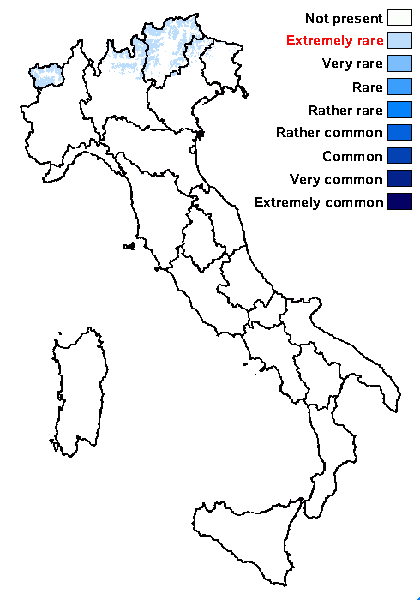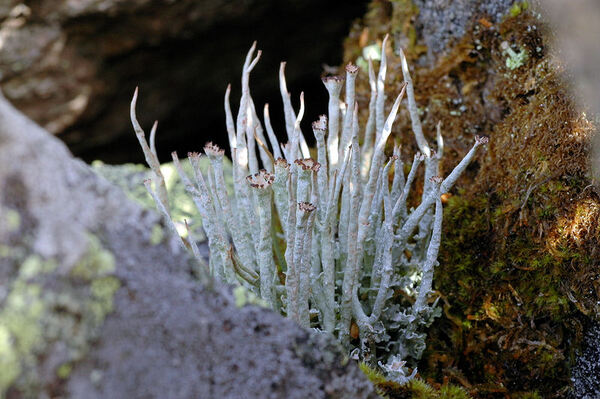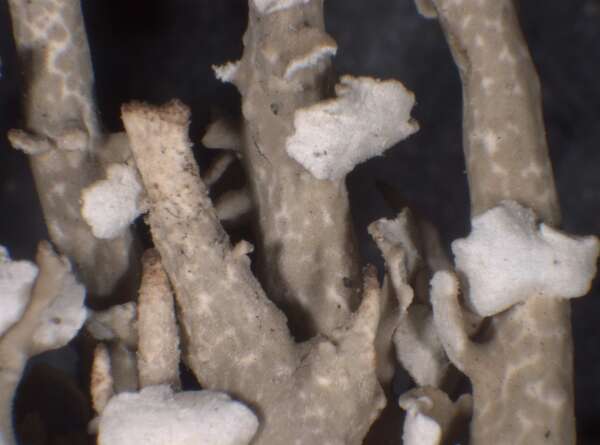Cladonia ecmocyna Leight.
Ann. Mag. Nat. Hist., ser. 3, 18: 406, 1866.
Synonyms: Cladonia elongata var. ecmocyna (Leight.) Räsänen; Cladonia gracilis var. ecmocyna (Leight.) Kernst.
Distribution: N - Frl (Tretiach & Hafellner 2000), Ven (Nascimbene & Caniglia 1997, Caniglia & al. 1999), TAA (Nascimbene & al. 2022), Lomb (Rivellini 1994, Rivellini & Valcuvia 1996, Gheza 2019, Gheza & al. 2022), VA (Piervittori & Isocrono 1999, Matteucci & Vanacore Falco 2015), Emil (Benesperi & al. 2007, Fariselli & al. 2020). C - Tosc (Benesperi & al. 2007).
Description: Primary thallus squamulose, ephemeral, the squamules middle-sized, 1-4(-5) mm long, greenish brown to greenish grey above, pure white beneath. Podetia elongate, hollow inside, dull glaucous green, greenish grey or greenish brown in sun-forms, sometimes browned or weakly pruinose at the tips, often yellowish at the emorient bases, 5-10 cm tall, 0.5-4(-5) mm thick, cupless or with narrow (1.5-5 mm wide) cups, esquamulose or sparsely squamulose in lower parts, the cortex subcontinuous to checkered-areolate, the areoles often separated by a network of white medullary interspaces. Apothecia rare, brown to almost black, convex, developing along the margins of cups. Asci 8-spored, clavate, thickened at apex, with a K/I+ blue tholus and a K/I+ strongly blue outer gelatinous sheath, Cladonia-type. Ascospores 1-celled, hyaline, ellipsoid. Pycnidia dark, pyriform, semi-immersed along the margins of the cups, with a colourless jelly. Conidia hyaline, curved. Photobiont chlorococcoid. Spot tests: K+ instantly yellow, C-, KC-, P+ red; yellow pigment at the base K+ red. Chemistry: atranorin, fumarprotocetraric acid, and terpenoids.Note: a mainly boreal-montane to subarctic-subalpine, circumpolar lichen found on organic soil and amongst bryophytes in cool depressions with a late snow lie near or above treeline; restricted to the Alps in Italy.
Growth form: Fruticose
Substrata: soil, terricolous mosses, and plant debris
Photobiont: green algae other than Trentepohlia
Reproductive strategy: mainly sexual
Commonnes-rarity: (info)
Alpine belt: extremely rare
Subalpine belt: extremely rare
Oromediterranean belt: absent
Montane belt: absent
Submediterranean belt: absent
Padanian area: absent
Humid submediterranean belt: absent
Humid mediterranean belt: absent
Dry mediterranean belt: absent

Predictive model
Herbarium samples
Growth form: Fruticose
Substrata: soil, terricolous mosses, and plant debris
Photobiont: green algae other than Trentepohlia
Reproductive strategy: mainly sexual
Commonnes-rarity: (info)
Alpine belt: extremely rare
Subalpine belt: extremely rare
Oromediterranean belt: absent
Montane belt: absent
Submediterranean belt: absent
Padanian area: absent
Humid submediterranean belt: absent
Humid mediterranean belt: absent
Dry mediterranean belt: absent

Predictive model
| Herbarium samples |
 Index Fungorum
Index Fungorum
 GBIF
GBIF




